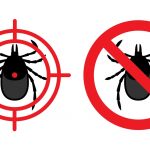 National Institutes of Health (NIH) scientists have filled a research gap by developing a way to study ticks that transmit viruses like Lyme Disease or Rocky Mountain Spotted Fever.
National Institutes of Health (NIH) scientists have filled a research gap by developing a way to study ticks that transmit viruses like Lyme Disease or Rocky Mountain Spotted Fever.
Scientist Jeff Grabowski at the Rocky Mountain Lab in Hamilton dissected deer ticks under a microscope using a fine pair of tweezers. He then removed three key organs – the midgut (or the tick’s digestive track), the salivary glands, and the synganglion nervous tissue (like the tick’s brain).
“Jeff was able to culture those teeny tiny organs in culture media,” said Marshall Bloom, chief of the National Institute of Allergy and Infectious Diseases’ Biology of Vector-Borne Viruses Section. “He infected them with Powassan virus or Langat virus. Sure enough the virus was able to infect the midgut and salivary gland cultures.”
Both Powassan and Langat viruses are a tick-borne diseases that can cause swelling in the brain, or encephalitis.
Now the scientists can look at what the virus is doing inside those cells. They can study how the virus infects the cells, and which salivary gland and midgut cells the virus infects.
“Once we have that figured out, we can start to identify specific genes in the tick organs that are responsible for supporting the growth of the Powassan virus or Langat virus,” Bloom said. “Once we identify those proteins, they become targets for counter measures or ways to prevent or modify the infection in people. So, it is actually a significant advance in the study of these viruses in the arthropod vector system.”
Bloom said Grabowski is the perfect scientist for this research, after studying under one of the world’s experts on tick-spread diseases, as well as under one of the world’s experts on ticks.
“He comes to Rocky Mountain Labs from his Ph.D. uniquely positioned to study the interactions of the virus with the tick,” Bloom said.
Bloom said the research has had a boost from visual enhancement.
“One of our colleagues, Kostya Psetarkin, was able to incorporate the gene for a florescent protein into the RNA of the Langat virus,” Bloom said. “The result is when that virus infects a cell the virus glows green under fluorescent light.”
The team can now look at the organs and see where the virus is infecting and spreading.
“The picture shows the Langat virus being bright green in the midgut of the tick’s intestine,” Bloom said. “Jeff is able to do this in live cultures, so he can look on a particular day, see where the infection is, then look the next day and see how the infection has spread.”
For this work the scientific team relied on the extensive expertise of tick expert Tom Schwan.
“He retired from RML a few years ago but his expertise and his generosity is frequently called upon by people working with tick born infections here,” Bloom said. “This is very cool.”
It also goes to the heart of Rocky Mountain Laboratories, which was founded on tick research.
Bloom said thousands of cases of Lyme disease are diagnosed each year. Powassan disease is less well known; according to the Centers for Disease Control and Prevention, about 75 cases have been reported in the past 10 years in the United States.
The Powassan virus can cause fever, headache, vomiting, weakness, confusion, seizures, memory loss, and death. No licensed treatments or vaccines are available, and earlier this year a New York man’s death was attributed to the Powassan virus.
“It is a challenging virus to study because it grows primarily in the ticks,” he said. “Our laboratory has been looking at the way Powassan virus behaves in laboratory strains in laboratory and wild mice.”
Source: Ravalli Republic

















